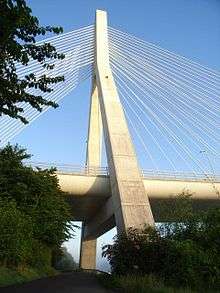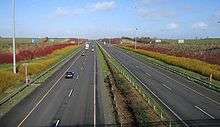M1 motorway (Republic of Ireland)
The M1 motorway (Irish: Mótarbhealach M1) is a motorway in Ireland. It forms the large majority of the N1 national primary road connecting Dublin towards Belfast along the east of the island of Ireland. The route heads north via Swords, Drogheda and Dundalk to the Northern Irish border just south of Newry in County Armagh, where it joins the A1 road and further on, the M1 motorway in Northern Ireland. It also forms a significant part of the road connection between Dublin and the Northern Irish cities of Newry, and Lisburn. The route is part of European route E01.
| |
|---|---|
.png)  | |
| Route information | |
| Part of | |
| Length | 87 km (54 mi) |
| Existed | 1983–present |
| History | Completed 1983–2005 Stages: Santry Bypass: 1983 Airport Motorway: 1985 Dunleer Bypass: 1993 Balbriggan Bypass: 1998 Dunleer to Dundalk: 2001 Drogheda Bypass: 2003 Airport to Balbriggan: 2003 Dundalk Bypass: 2005 |
| Component highways | |
| Major junctions | |
| South end | Dublin (Turnapin) |
| North end | Ballymascanlon |
| Location | |
| Primary destinations | Dublin Airport, Swords, Balbriggan, Drogheda, Dundalk |
| Road network | |
Route

Almost the entire length of the N1 has been upgraded to motorway standard and is designated the M1 motorway. It runs from the Junction 3 of the M50 ring road in Dublin, past Cloghran, Swords, Balbriggan, Drogheda and Dundalk before ending at Ballymascanlon north of Dundalk. It by-passes many towns through which the N1 travelled.[1] The original N1 route now forms the R132.[2] At Ballymascanlon, it becomes the N1 dual carriageway and continues to the border with Northern Ireland. The motorway section of the N1 uses the M1 designation. Small yellow route markers along the motorway route also read N1.
The motorway was built in several stages as short disconnected bypasses, replacing the original N1 route. The first section opened (in 1983) was from Whitehall to Coolock Lane followed (in 1985) by the Airport Motorway between Whitehall and Dublin Airport, only the third section of motorway opened in Ireland. 1980s style direction signs were still intact on this route up until 2006. Part of this original M1 is now a spur to Dublin Airport, while another part between Whitehall to the Port Tunnel portals is now narrowed to two+one lanes (although still grade separated) as a result of the Dublin Port Tunnel work.
There are toll fees for use of the motorway between junctions 7 and 10, the section which forms the Drogheda bypass. Work began in 2004 on a bypass of Dundalk, and was completed three months ahead of schedule in 2005, extending the motorway to just south of the border.
Construction finished in 2007 on a cross-border stretch of grade-separated dual-carriageway linking the northern end of the M1 with the A1 near Newry in County Armagh. This was opened to traffic on 2 August 2007. Its length is 14 km, 4.6 km north of the border and 9.4 km south of the border. This allows traffic to flow freely from Dublin Port on motorway/dual-carriageway standard road to the Hillsborough Roundabout, located south of Lisburn.
A 120 km/h speed limit applies on the vast majority of the M1, the exception being an 80 km/h limit between Junction 1 and Junction 2 at Dublin Airport. The lower speed limit is credited to the much higher volumes of traffic on this stretch.
Junctions


This is Transport Infrastructure Ireland's Exit numbering scheme for the M1.[3] As of 2011 all junctions feature their number on road signs.
| Northbound exits (read up) | Junction | Southbound exits (read down) |
| Entering Northern Ireland Road continues as A1 |
— | Entering Republic of Ireland Start of N1 |
| Jonesborough Note: Sliproad crosses the border half way up | Jonesborough, Carrickcarnan (R132), Customs and Excise | |
| No exit | Ravensdale (R132) | |
| Northbound exits (read up) | Junction | Southbound exits (read down) |
| Dundalk, Ballymascanlon (N52) | Dundalk, Ballymascanlon (N52) | |
| Castleblayney, Dundalk (N53) | Castleblayney, Dundalk (N53) | |
| Dundalk, Mullingar (N52) | Dundalk, Mullingar (N52) | |
| Castlebellingham Services | Castlebellingham Services | |
| Castlebellingham, Tallanstown (R166) | Castlebellingham, Tallanstown (R166) | |
| Ardee, Derry (N33 (N2)) | Ardee, Derry (N33 (N2)) | |
| Dunleer, Dromin (R170) | No exit | |
| Dunleer, Collon (R169) | Dunleer, Collon (R169) | |
| No exit | Monasterboice (R132) | |
| Drogheda North, Navan (N51) | Drogheda North, Navan (N51) | |
| Drogheda, Donore | Drogheda, Donore | |
| Drogheda, Duleek (R152) | No exit | |
| Julianstown, Drogheda South (R132) | Julianstown, Drogheda South (R132) | |
| Balbriggan, Naul (R132) | Balbriggan, Naul (R132) | |
| Balbriggan (R132), Balbriggan Services | Lusk, Rush (R132), Balbriggan Services | |
| Lusk services | Lusk services | |
| Skerries, Rush, Donabate (R132) | Swords (North), Malahide, Donabate (R132 (R126)) | |
| Swords (Centre) (R125) | No exit | |
| Dublin Airport, Swords (South) (R132) | Dublin Airport, Swords (South) (R132) | |
| Start of M1 motorway | Malahide (R139), ALL OTHER ROUTES (M50 Motorway continues as M50 for Dublin and Dublin Port | |
All-Ireland route
The upgrade of the N1 is now complete in the Republic of Ireland, the first major route to be completely upgraded to motorway/dual carriageway standard (outside of Dublin city centre) as per the National Development Plan. The Northern Irish authorities have no plans to replace the A1 route (currently dual carriageway) with motorway, although many junctions have now been grade separated. Currently, to drive from Dublin city centre to Belfast, one travels along the M1 (Republic of Ireland), N1, A1 and M1 (Northern Ireland).
Motorway service areas
The first official on-line Motorway service area in Ireland opened on the M1 on 8 September 2010, located near Lusk. A second near Castlebellingham (M1 North service area) opened on 29 September 2010. Each location has northbound and southbound facilities, with no connection across the motorway between each side. Open 24 hours a day, they provide fuel and food and are of a design similar to those found in other European countries. The service areas are run by a consortium of companies known as Superstop.
ITS on the M1
As with other sections of Irish motorways which feature Variable-message signs, the M1 is also connected to an Intelligent transportation system providing real-time journey time information for motorists. The system works by recognising vehicle number plates at intervals along the motorway, and uses this information to calculate average vehicle speeds and hence travel times. Northbound, VMSs near Malahide and Balbriggan provide information on the journey times to the Drogheda (J7) and Dundalk (J16) exits. Similar signs southbound provide information on the travel time to Dublin Airport and the Dublin Port Tunnel.
Roadside art on the M1
Roadside art is funded under the Percentage For Arts Scheme where 1% of the scheme budget is allocated to roadside art with a cap of €63,000. The local authorities decide on a theme and are responsible for commissioning the work, usually by open competition.[4] There are several examples along the M1
- The Beehives. Three corbelled beehives on the Balbriggan bypass by artists Robert McColgan and Irene Benner made of cut stone in 2001 – Inspired by the tale of St. Molach, a beekeeper.[5]
- An Tarbh Donn, a three-metre-high (9.8 ft) bull on the Dundalk bypass by artist Micheál McKeown. Of metal mesh on a concrete base. Inspired by the Bull in the Táin Bó Cúailnge.[6]
See also
| Wikimedia Commons has media related to M1 motorway (Republic of Ireland). |
References
- http://www.irishstatutebook.ie/2012/en/si/0053.html S.I. No. 53/2012 — Roads Act 1993 (Classification of National Roads) Order 2012
- http://www.irishstatutebook.ie/2012/en/si/0054.html S.I. No. 54/2012 — Roads Act 1993 (Classification of Regional Roads) Order 2012
- Ordnance Survey Ireland Motorway Schemeta
- "Archived copy". Archived from the original on 4 June 2009. Retrieved 6 March 2010.CS1 maint: archived copy as title (link)
- http://www.fingalarts.ie
- http://www.createlouth.ie
